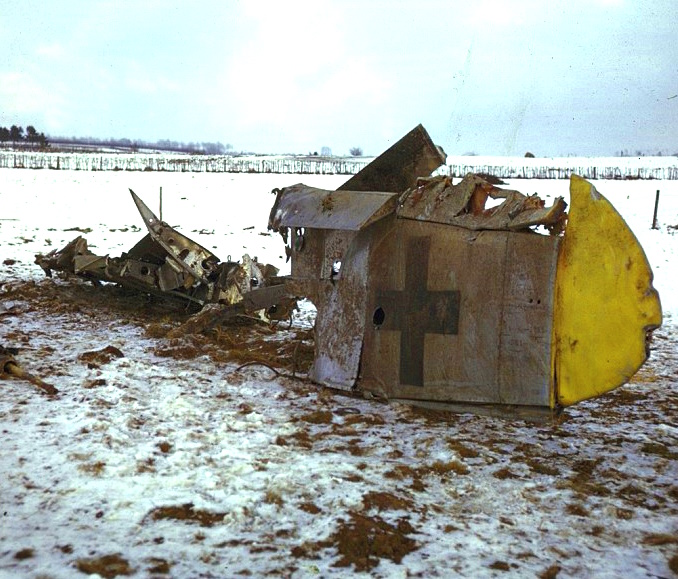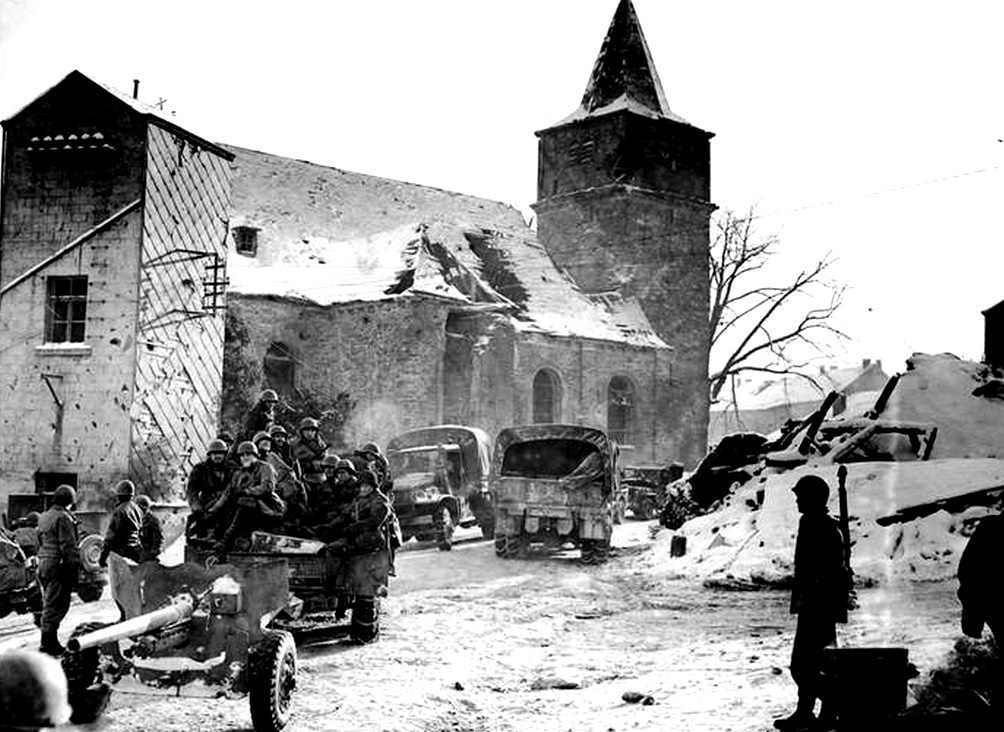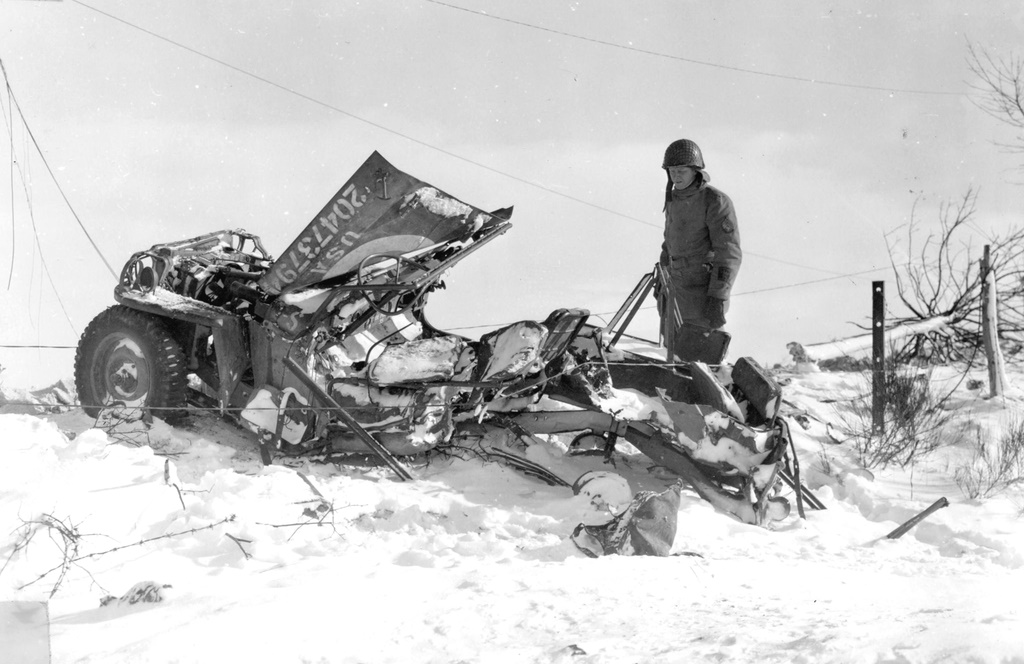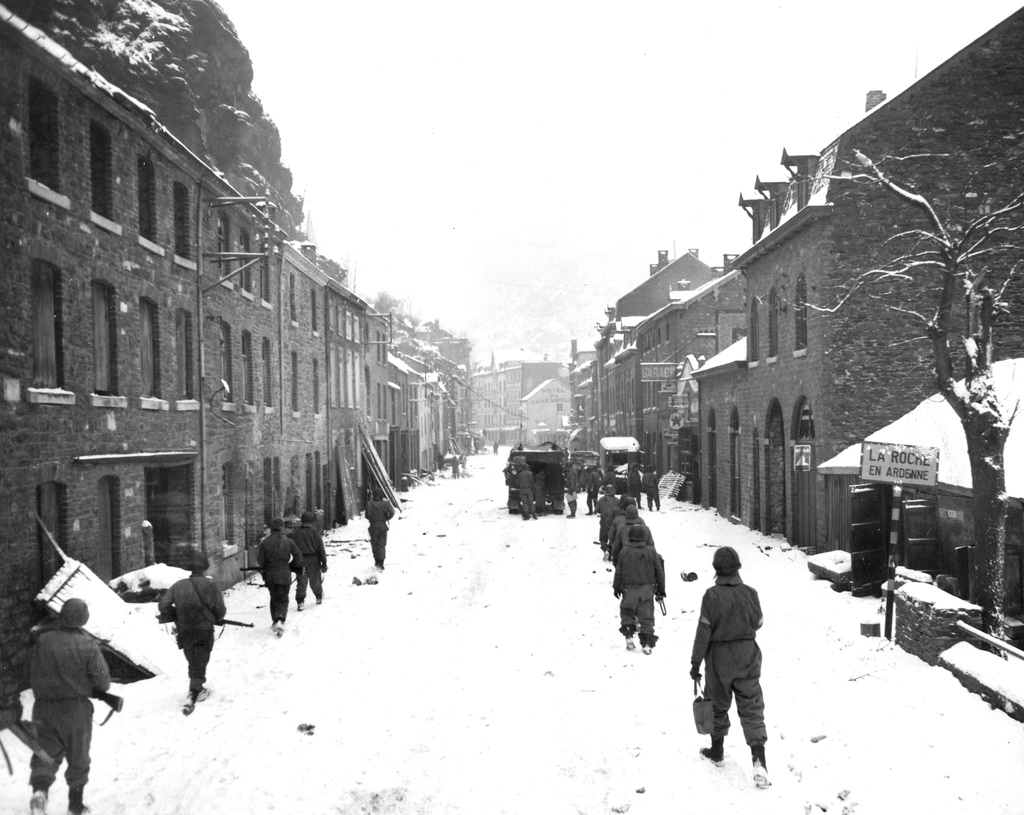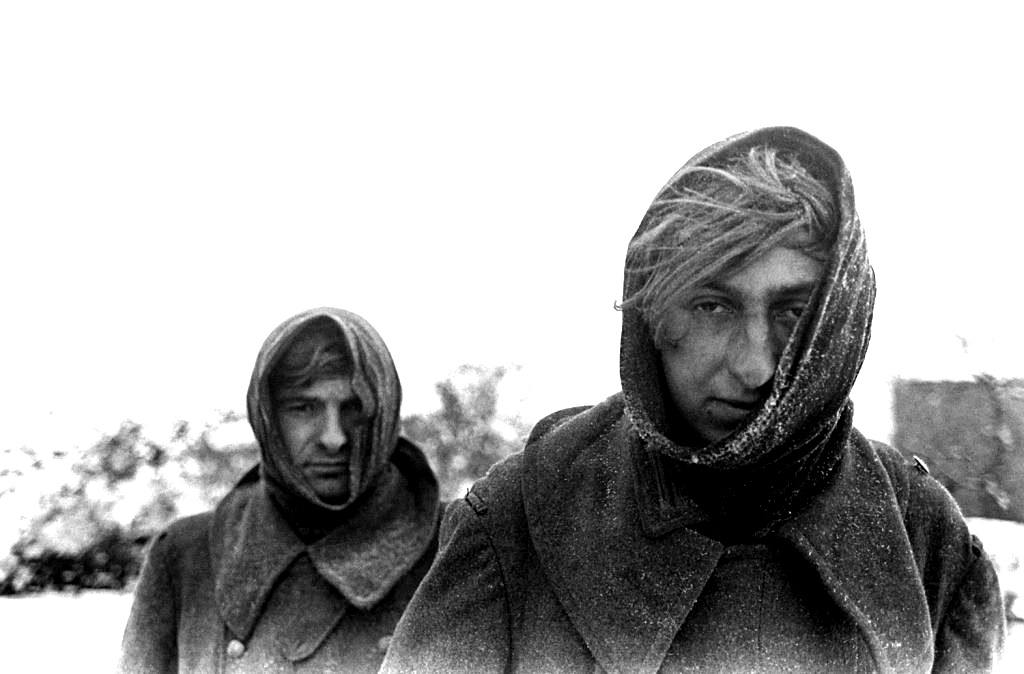THE TURNING POINT
We took Consy the way we look at most of the strong points – by going around it. When we took Devantave on January 6, we out flanked Consy on the left. Then we sent two battalions into the woods west of Consy – the 1/290-IR (75-ID attached 1-10/01-45), into the upper half of the woods and the 2/334-IR into the lower half – and the enemy was squeezed out in the middle. He did not choose to hold even this commanding position at Consy at all costs. By January 7, Consy was virtually cleaned out though the woods on the right flank were not completely safe for another two days. The turning point of the entire action probably came on January 7, not when we had to fight the hardest but when progress was still relatively easy. On the left flank, after we took Odeigne on January 6, the 2/333-IR, was sent out the next day to capture the vital crossroads where the La Roche Road and the Houffalize Road meet (Parker Crossroads – Baraque de Fraiture). The weather was miserable. A snowstorm whipped up during the attack. Nevertheless, by nine-thirty the crossroads was ours. Prisoners, frozen, hungry, and disorganized, were picked up in small, wandering groups. They said they were surprised again. An attack in such harsh weather was completely unexpected. Our interrogators heard that story almost every day.
As soon as we captured the crossroads, the enemy was deprived of the only two first-rate roads to the east, the La Roche Road and the Houffalize Road. From then on, he must have been inhibited in his intentions, though he would never retire without a fight. Nevertheless, he always had to consider his chances of successfully pulling his forces out of the trap were getting slimmer and slimmer. Partly because German resistance above the La Roche Road on our right flank was so much stronger than on our left, we were able to cut the road first on the extreme left of our zone at the crossroads. As we gained full control of the road, we continued to move from left to right. Next, one of our Task Forces came down from Amonines to Dochamps and from Dochamps we launched the attack, on one of the enemy’s key positions, Samrée. The trip from Amonines to Dochamps was the same, old story. The road, though the best in the sector, was so icy and narrow that the tanks were held up repeatedly. Roadblocks, which took about two hours each to reduce on average, some small arms fire but this time very little artillery, represented the enemy’s main effort to hold us up. We took the high ground northwest of Dochamps on the night of January 6 and were able to move into Dochamps the next night.
One incident was symbolic. After we had spread out in the village, a German tank and 60-80 infantrymen suddenly pulled out from behind the church and made for Samrée. Our tank destroyers could not fire a shot because their turrets were frozen, a striking example of weather conditions that lessened the effectiveness of our mechanized equipment and threw the main burden of attack and defense on our infantry. First, we had to take two other hills, northeast and northwest of it. Our troops had to move through 1500 yards of rolling ground in knee-deep snow. The enemy had perfect observation every inch of the way. To tell the truth, it was hard to see how we could make it. At six-thirty, January 9, the 3/335-IR, went out of Dochamps to get those hills. By nightfall, it had progressed to the edge of some woods about 1500 yards from Samrée on the west side of the road and had taken one of the heavily wooded hills guarding the town. Love Co was withdrawn and sent around through Dochamps to occupy the second hill on the east side of the road. That night, our artillery concentrated on Samrée. The next day, at seven-thirty, the 3/335-IR, pushed forward to capture the eastern half of Samrée and was joined by the 1/335-IR, which aimed at the western half.
This time, tanks went in first, blazing away with all their guns, a sight a doughboy loves best, thinking of all the doughboys it takes to work up that much firepower. By about nine-thirty, the village was cleared. We were pleasantly surprised. The enemy was determined to delay us but as long as we showed our determination to move forward, we could always take what we wanted. The infantrymen who went into Samrée had been fighting steadily for eight days, for 192 hours. They were certainly helped by the fact that the La Roche Road had been cut three days earlier. The artillery concentration on Samrée was extremely effective. But in the end, men had to live in some more freezing cold and wade through some more snow drifts, now as much as five feet high, to get it for us.
THE CAPTURE OF LA ROCHE
The battle of La Roche was a good example of the battle of supply and the battle of stamina which every battle in the bulge was. The roads to La Roche were particularly bad, the hills particularly high and the woods particularly dense. A few tanks and trucks turned the snow on the roads into ice and trouble started. The doughboy’s best friend became an engineer and an artilleryman. The main attack was launched from Devantave by the 1/334-IR. The first objective was Marcouray. Over a hundred guns softened up the village for five minutes. Then, at 1500, January 7, the infantry jumped off. The ground was rocky and steep. It was snowing again. Thirty minutes later, all German resistance in Marcouray was overrun. We found that the enemy positions were carefully prepared. Snow was a natural camouflage. Fortunately, we were achieving tactical surprises and much of the preparation was wasted. As prisoner after prisoner told us, the weather and terrain were so bad that our infantry was simply not expected. That is one compensation for impossible conditions – they are apt to lead the enemy to drop his guard. The enemy’s surprise at Marcouray was shown by the equipment he was forced to leave behind. We picked up 36 vehicles: 8 half-tracks, 2 command cars, 6 US jeeps, 6 civilian-type cars, 5 six-wheeled recon vehicles, 5 US tanks, 2 German 1 1/2 ton trucks, and 2 US 1 1/2 ton trucks. A battle for supplies broke out that night. It was an engineer’s nightmare.
The engineers dumped sand on the road and put up luminous markers. A convoy of jeeps slipped through with food and ammunition. But two trucks piled into each other, AT guns behind them, piled up and the only road forward was blocked. It was blocked all night and part of the next morning. On another road, two prime movers and their guns went over an embankment. Four tanks slid off the road and stuck. Nevertheless, the attack was pushed. At 1300 the next day, January 8, the doughboys of the 1/334-IR, in Marcouray picked themselves up, look what they had and could stuff in their pockets, and took off for Cielle, the last little village at the bend of the Ourthe before La Roche. Less than three hours later, they took Cielle the way they had taken Marcouray, only the climb was harder. Between Cielle and La Roche, dominating the entire bend, was a stretch of very high ground, Hez de Harzé, the key to La Roche. Of all our objectives, this was considered the most impossible. An estimated company of enemy infantry was dug in on the forward slope of the hill. The hill was peculiar in one respect. The Germans could see us in Cielle from the hill but it was so heavily wooded that we could not see La Roche from it.
It was the last and hardest part of the job to make La Roche untenable. At 1100, January 9, the 2/334-IR jumped off from Cielle. George Co led a column of companies to the hill. Enemy tank, machine gun and the semi-automatic fire stopped them short. By 1250, however, George Co had crept up to the base of the hill. Before the advance on foot was resumed, we brought all available artillery and mortar fire to bear on the hill. By 1310, as a result of this concentration, the enemy infantry and one tank were seen falling back on the road towards La Roche. How Co’s machine guns made the enemy’s retreat costly. By 1610, the 2nd Battalion was firmly established on the Hez de Harzé. As it turned out, the chief value of the hill was the fact that the enemy did not have it, but this was no small accomplishment in itself. The capture of La Roche was relatively uneventful. The first Allied troops to set foot in it was a patrol from the 334-IR which entered the town at 1600, January 10. Since half of La Roche was in the 84-ID’s zone and half in the British 51st Division’s zone, because the Ourthe ran through the town, La Roche was occupied by both divisions. At 0900, January 11, the 4th Cavalry Group, attached to the 84-ID, took over the eastern half of La Roche which was practically deserted. Two hours later elements of the British 51st Division went into the western half. There was every evidence that the enemy had suffered heavily from our artillery concentrations on the town, once the most beautiful in the Ardennes, and had begun to pull out by January 10.
FROM LES TAILLES TO DINEZ
When we look La Roche, we sealed the fate of the bulge. Yet in no sense did it mean that the fighting became less difficult. The terrain and weather were still the enemy’s chief allies. His forces had more and more hills and woods to withdraw to. Above all, the German command was now fighting for time, time to regroup and reorganize behind the Siegfried Line, time to meet the overwhel ming Russian threat. There were some significant differences between the two phases. As long as our main objective was La Roche, the enemy’s main effort was made on the right flank. As soon as we took the La Roche Road and Houffalize became our main objective, the enemy’s main effort was made on the left flank. In the second phase, the 333-IR was temporarily attached to the 2-AD. The 84-ID was given the right half of the zone, and the 2-AD the left half. In this phase, we were faced with elements of the 116.Panzer-Division and the Panzer-Lehr-Division. As far as the La Roche Road, the 333-IR had advanced with relative ease. Once beyond the road, it ran into much more trouble.
In Les Tailles and at the edge of the woods to the south, an estimated enemy battalion was dug in. On the other side of the Houffalize Road, an estimated reinforced company was holding Petites Tailles. The 2nd Battalion went out from the La Roche Road to Les Tailles, the 1st Battalion to Petites Tailles. The experiences of both were significantly similar. To get to Les Tailles, we had to cross some more woods. The German positions were well-camouflaged. The enemy’s fields of fire and barrages were well-planned to catch us as we came out into the open. At 0800, January 12, Fox Co and George Co jumped off. As they came out of the woods north of Les Tailles, they were met by very heavy fire and were held up. At 1500, they began to move again. Ten minutes later, George Co and tanks were entering Les Tailles but the opposition was so sharp that the village was not cleared until 2100. About 140 prisoners were taken. This happened again and again – we had to fight hard for a place but when we took it we gathered in batches of prisoners. Looked at more closely, however, this phenomenon may tell us a good deal about a German stratagem in fighting this final phase of the war.
Petites Tailles was a striking example. To get to Petites Tallies, the 1st Battalion had to move across relatively open ground down the Houffalize Road. The enemy was able to bring direct and observed fire on our troops all the time. A continuous effort was made to approach the village from the flanks but the open terrain made the maneuver difficult. The 1st Battalion jumped off at 0800 in the morning, January 12, but the enemy’s heavy weapons and tanks held it up all day and inflicted heavy casualties. Under cover of darkness, however, we tried again. The fighting was hard but Petites Tailles was ours by 2100 in the evening. By chance, both Les Tailles and Petites Tailles were cleared at the same time. In Petites Tailles, we picked up 70 prisoners. Most of them were non-German. The German officers and non-coms had gotten out while the getting out was still good. The rest were left to their own fate without orders. By the time they fell into our hands, they were meek indeed. In some instances, they would walk in squad columns on the street asking for an ‘Amerikaner’ to surrender to. In at least one case, a group of twenty, completely equipped with rifles and
machine guns, tacked onto one of our platoons. In the dark, it is not so easy to surrender successfully.
What had happened? In this village, which cost us so much blood to take, the prisoners were very deceptive. The German officers and non-coms had fled to fight from another village some other day. The prisoners we picked up were the expendables. Any one of these prisoners behind a machine gun under a tough, experienced German officer or non-com in the middle of the day was one man. That night, in a prisoner’s cage, he was another man.
